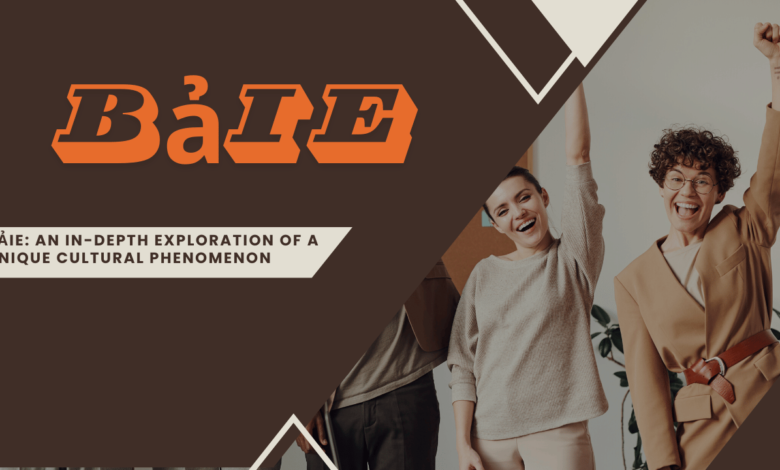Bảie: An In-Depth Exploration of a Unique Cultural Phenomenon

Bảie is a term deeply rooted in specific cultural traditions, representing a fascinating aspect of human social interaction and artistic expression. This article explores the concept of bảie comprehensively, examining its origins, cultural significance, variations across different regions, and impact on contemporary society. By delving into the intricacies of bảie, we hope to shed light on this unique phenomenon and its enduring relevance.
Origins and Historical Context
The term bảie, though not widely recognized in mainstream discourse, has historical roots that trace back to ancient traditions. Historically, bảie was often associated with community gatherings, festivals, and ceremonies, serving as a medium for storytelling, dance, music, and other artistic expression. It was a way for communities to come together, celebrate their heritage, and pass down traditions from one generation to the next.
In various cultures, bảie played a pivotal role in social cohesion. For instance, in some Southeast Asian communities, bảie ceremonies were integral to village life, marking important events such as harvests, weddings, and religious observances. These gatherings were characterized by elaborate costumes, intricate dance routines, and a rich tapestry of music and song; each element imbued with symbolic meaning.
Cultural Significance
Bảie is more than just a form of entertainment; it is a vital cultural expression that reflects a community’s values, beliefs, and history. The significance of bảie can be seen in several key aspects:
Preservation of Heritage
Bảie serves as a living repository of cultural heritage. Through its performances and rituals, bảie preserves traditional knowledge, folklore, and artistic practices that might otherwise be lost to time. This preservation is crucial for maintaining a sense of identity and continuity within a community.
Social Bonding
Participating in bảie activities fosters social bonds and strengthens community ties. The collaborative nature of bảie performances, which often require the involvement of multiple participants, promotes a sense of unity and shared purpose. This social aspect is essential in rural and close-knit communities where collective activities are a cornerstone of social life.
Ritualistic and Spiritual Dimensions
In many cultures, bảie is intertwined with spiritual beliefs and practices. It is often performed as part of religious ceremonies or rituals as a conduit for spiritual expression and communication with the divine. The ritualistic elements of bảie, such as specific dance moves or chants, are believed to hold sacred significance and are meticulously preserved.
Variations Across Regions
The expression of bảie varies significantly across different regions, reflecting the diverse cultural landscapes in which it is embedded. Here are some notable regional variations:
Southeast Asia
In Southeast Asia, particularly in countries like Vietnam and Thailand, bảie is often associated with traditional festivals. Vietnamese bảie performances, for example, are characterized by conventional musical instruments, elaborate costumes, and choreographed dance routines that tell stories from folklore and mythology.
Africa
In various African cultures, bảie-like traditions are integral to community life. These performances often involve drumming, singing, and dancing, with each element playing a crucial role in storytelling. The rhythms and movements in African bảie are not just artistic expressions but are also deeply connected to the community’s spiritual and historical narratives.
Latin America
In Latin American countries, bảie manifests in vibrant dance forms such as samba, salsa, and cumbia. These dances are popular entertainment and a celebration of cultural diversity and history. The energetic and colorful performances are a testament to the region’s rich cultural heritage and fusion of indigenous, African, and European influences.
Impact on Contemporary Society
In the modern era, bảie continues to evolve, adapting to contemporary contexts while retaining its traditional essence. Its impact on modern society can be observed in several ways:
Cultural Festivals and Tourism
Bảie performances are a significant attraction at cultural festivals and events worldwide. These festivals provide a platform for showcasing traditional arts and crafts, attracting tourists, and fostering cultural exchange. The commercialization of bảie through tourism also helps the economic development of the communities that preserve these traditions.
Education and Awareness
Bảie is increasingly incorporated into educational programs to promote cultural awareness and appreciation among younger generations. Schools and cultural institutions often organize workshops and performances to teach students about the history and significance of bảie, ensuring that these traditions are passed down and appreciated.
Artistic Innovation
Contemporary artists and performers draw inspiration from bảie, incorporating traditional elements into modern art forms. This fusion of old and new creates innovative expressions that resonate with a global audience. From contemporary dance performances to multimedia art installations, the influence of bảie is evident in various creative endeavors.
Challenges and Preservation Efforts
Despite its cultural significance, bảie faces challenges in the modern world. Rapid urbanization, globalization, and the erosion of traditional lifestyles threaten the preservation of bảie. However, several efforts are being made to safeguard this cultural heritage:
Documentation and Archiving
Efforts to document and archive bảie performances, including recording music, dance, and oral histories, are crucial for preserving these traditions. Digital archiving and multimedia projects help ensure that bảie can be accessed and studied by future generations.
Community Initiatives
Local communities play a vital role in preserving bảie. Grassroots initiatives, such as community-based cultural centers and traditional arts groups, actively work to keep bảie alive through regular performances, workshops, and cultural events.
Government and NGO Support
Governments and non-governmental organizations (NGOs) also contribute to the preservation of bảie by providing funding, resources, and platforms for cultural expression. Policies that support cultural heritage preservation and the inclusion of bảie in national and international cultural programs are essential for its survival.
Conclusion
Bảie is a multifaceted cultural phenomenon encompassing history, art, and social interaction. Its significance extends beyond mere entertainment as a vital link to the past and a cornerstone of cultural identity. As we continue to navigate the complexities of modern life, the preservation and celebration of bảie remain essential for maintaining the rich tapestry of human cultural heritage. Through collective efforts, we can ensure that bảie continues to inspire and connect people across generations and regions.
You May Also Read: Crossovericon.eu: The Hub for Cultural and Artistic Exchange




